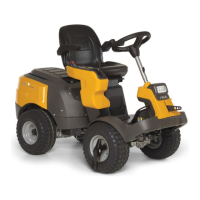Edition
2018
Workshop Manual
PARK PRO 340 IX
Chapter
1 General instructions
Page
6
B. Safety principles to be implemented
All the machines have been built in compliance with the strictest European standards on
safety. To keep the initial level of safety unaltered over time, it is important for the Service
Centre to act accordingly and carry out all necessary checks and inspections whenever
possible.
In particular, each time work on the machine is requested it must:
1. check:
• correct operation of the safety microswitches;
• that none of the safety guards or devices have been removed;
• that none of the safety/warning decals have become illegible/damaged (these are
considered integral parts of the safety devices).
2. it must also:
• restore correct operation of any safety devices which may have been removed or
tampered with;
• reinstall any ineffective, damaged and/or missing safeguards;
• replace any illegible decals;
• avoid carrying out any work or modication to the machine or engine which changes
its operating performance or could lead to use of the machine which is improper or in
any case different to the use it was designed and homologated to carry out;
• inform the Customer that any failure to observe the aforementioned points will
automatically nullify the warranty and exonerate the manufacturer from all liability.
C. Precautions during work
The interventions described herein do not usually entail any particularly hazardous
situations except for those usually linked to any kind of mechanical work. Any risks can be
avoided by taking the usual amount care and attention required for this kind of work.
As well as observance of the usual rules and regulations on the prevention of accidents
common to workshops, please remember to:
• remove the keys from the ignition before commencing any work;
• protect hands with suitable work gloves, especially when working on or near the cutting
device;
• make sure that the work in progress does not lead to any accidental fuel leaks or spills;
• never smoke when working on the fuel tank or handling fuel;
• not inhale oil or fuel fumes;
• immediately clean up any traces of spilt fuel;
• test the engine only in a well ventilated environment or in the presence of an adequate
exhaust fumes extractor system;
• not disperse oil, fuel or other hazardous waste into the environment. This kind of waste
must be disposed of in compliance with the relative legislation in force;
• make sure no-one can inadvertently carry out actions which could compromise the safety
of the mechanic working on the machine.
D. Tools required
All the operations described herein can be carried out using the tools usually available in a
good vehicle repair workshop.
1.1.7 Lifting
Before starting any work under the machine, check the load capacity of the lifting
equipment or the jack.

